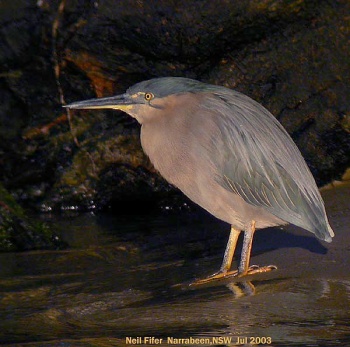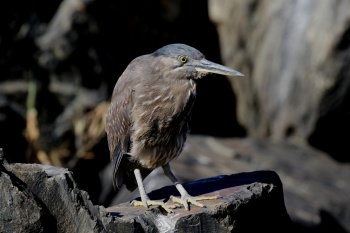Alternative names: Little Green Heron; Green-backed Heron; Green Heron (when treated as conspecific with Green Heron)
Includes: Lava Heron, Little Heron, Mangrove Heron
- Butorides striata
Identification

Photo © by Alok Tewari
Keoladeo National Park, Bharatpur, India, 22 June 2017
Length 35-48 cm (14-18 in), wingspan 52-60 cm, weight 135-250 g. A dumpy little heron with a large head and bill. Flight with neck folded low, with quick beats of wings. In flight, feet protrude from tail.
- general colour blackish green;
- below grey
- throat and down the foreneck white (dependent on subpecies)
- crown with erectile feathers, extending down nape, at rest
- scapulars and wing-feathers margined with white, or buffy-white
- hind-neck, sides of face, abdomen, sides of body, axillaries, and under wing-coverts grey, somewhat paler on the vent and under tail-coverts
- cap black
- throat and fore-neck white with an irregular line of dark chestnut-brown feathers down the middle which spreads out and becomes pale rufous on the breast
- central underparts have a whitish line, edged and/or mottled rufous in many subspecies
- wings blackish with greyish, dull dark greenish or brownish edging
- outer edge of wing white
- belly, flanks, neck and head are greyish to purplish-brown or buffy-brown, depending on subspecies
- lores yellow, bluish, or blackish
- legs and feet grey brown in front, yellow behind, yellow to reddish orange when breeding
- iris yellow, deep orange when breeding
- lores green to blue, yellow when breeding
- bill black above, yellow green below with black tip, entirely black when breeding
Gender can be told by colour of the legs, orange or red in males and yellow in females according to Forbes-Watson (1969) [3], though this statement has rarely been repeated.
Juvenile
- Brown
- Whitish-buff streaking on underparts, neck and head
- Spotting on wings
- According to some authors the amount and intensity of the streaking on the chest is a sign of the birds age, with streaks fading with age.
Two Australian subspecies, B. s. macrorhyncha and B. s. stagnatilis, occur in both a grey and a rufous morph, while the normally grey nominate B. s. striata also occurs in a rare rufous-necked morph (confirmed for Peru and Bolivia; possibly also elsewhere).
Similar Species
Adults are generally distinctive. Rufous-necked morph of nominate race is paler, and has a greyer belly than the Green Heron (limited overlap between the two in coastal Venezuela, Trinidad and Tobago, coastal northern Colombia and eastern Panama).
Hybrids between Striated and Green Herons showing intermediate plumage have been recorded. Juveniles of Striated and Green Heron are virtually inseparable.
Distribution
Widespread in South America (except far south and the Andes), sub-Saharan Africa (except far south), warmer parts of Asia, coastal northern and eastern Australia, and islands in the Indian Ocean and Pacific Ocean. See Subspecies, below, for further information on range. Most subspecies are sedentary or with local dispersal only, but two Asian races, B. s. amurensis and B. s. actophilus, migrate south following breeding.
Generally common and widespread. Some localised subspecies are rarer, and it has been estimated that only around 100 individuals remain of the subspecies B. s. patruelis.
Taxonomy
The scientific name was recently corrected from Butorides striatus to Butorides striata. This species was previously sometimes placed in the genus Ardeola.
The monophyly of all subspecies of Striated Heron with respect to Green Heron is yet to be established. Some authorities include Green Heron as a further subspecies to avoid this question; others have suggested that Striated Heron may be split into several species in the future.
Various subspecies or groups of subspecies may be split as separate species: sundevalli as "Lava Heron", B. sundevalli; asian mainland and african forms as "Little Heron", B. atricapillus and other asian taxa as "Mangrove Heron", B. javanica [5].
Subspecies
Very variable, with 21-22 taxa often accepted. Clements recognises the following subspecies [1]:
American subspecies
- B. s. striata: Most of South America, except for the far south and the Andes. Also in eastern Panama and Trinidad (Tobago mainly has Green Heron).
Galapagos subspecies
- B. s. sundevalli "Lava Heron". Galapagos. [Entire plumage dark grey to blackish. Legs seem to be heavier than for South American forms.]
African and Middle East subspecies
- B. s. atricapilla: Africa south of the Sahara. [Streaks on the throat tawny rufous. Grey ornamental plumes on the back, wing coverts edged with sandy buff, crown is greenish black. Upper mandible dusky, lower mandible greenish yellow with dusky margins. Iris light yellow.]
- B. s. brevipes: Somalia and the Red Sea and Arabian coasts.
Indian Ocean subspecies

Photo © by Neil
Narrabeen, Sydney, New South Wales, Australia, July 2003
- B. s. crawfordi: Aldabra Islands and Amirante Islands.
- B. s. rhizophorae: Comoro Islands.
- B. s. rutenbergi: Madagascar, Réunion. Similar to B. s. atricapilla but generally darker, with a redder neck, somewhat reminiscent of Green Heron.
- B. s. degens: Seychelles.
- B. s. didi: northern and central Maldives.
- B. s. albidula: southern Maldives.
- B. s. albolimbata: Chagos Archipelago (including Diego Garcia).
- B. s. spodiogaster: Andaman Islands, Nicobar Islands, and islands off western Sumatra. [Throat and cheek-stripe ashy or brown, not distinctly indicated, abdomen rusty. Sides of neck and sides of body dark, sooty, slate colour; cheeks and ear coverts also slate colour. Bill black, lower portion of lower mandible, from base to tip, edged pale horny.]
Asian subspecies
- B. s. amurensis: Southeast Siberia, northeast China, Japan; migrates south to Sumatra and Philippines in winter. As B. s. javanicus but stockier and longer-winged (wing 17-22 cm, compared to 17 cm for B. s. javanicus) and with a coarser bill.
- B. s. actophila: Eastern China to Myanmar and northern Vietnam; migrates south to Sumatra, Borneo, and Nicobar Islands in winter.
- B. s. javanica (syn. B. s. chloriceps): Pakistan, India, Sri Lanka, Thailand, Greater Sundas, Sulawesi. [Throat and foreneck uniform or mottled with blackish, but never streaked with tawny rufous. Plumes with white-shaft lines, scapular feathers green, sometimes with grey tips. Wing coverts green with buff margins. Below the eye there is a streak of greenish black extending along the ear coverts, edged with a white streak on the top, a second streak from the lower mandible along the cheeks. Upper mandible black with longitudinal yellow stripe below the nostrils. Facial skin and legs green.]
- B. s. carcinophila: Taiwan, Philippines, and Sulawesi
Australasian subspecies

Photo © by Hans&Judy Beste
Gold Coast, Queensland, Australia, August 2018
- B. s. steini: Lesser Sundas.
- B. s. moluccarum: Moluccas.
- B. s. papuensis: Northwest New Guinea.
- B. s. littleri: northeastern Australia (northeastern Queensland)
- B. s. idenburgi: Northern New Guinea.
- B. s. flyensis: South central and southeast New Guinea.
- B. s. rogersi: Northwest Western Australia.
- B. s. cinerea: Northeast Western Australia.
- B. s. macrorhyncha: Eastern Australia, New Caledonia, Loyalty Isles.
- B. s. stagnatilis: Northern-central Australia. Sides of neck washed with rusty brown like the sides of the body, abdomen, cheeks and ear coverts rusty brown.
- B. s. solomonensis: New Hanover, Solomons, Fiji.
- B. s. patruelis: Tahiti, Society Islands.
Habitat
The species shows a preference for forested water margins such as mangrove-lined shores and estuaries, or dense woody vegetation fringing ponds, rivers, lakes and streams.
Other suitable habitats include river swamps, canals, artificial ponds, salt-flats, mudflats, tidal zones, exposed coral reefs, reedbeds, grassy marshland, pastures, rice-fields and other flooded cultivation. In plains to an altitude of 750m, occasionally up to 1300m.
There have also been a few records in savannah woodland, where the bird would hunt tadpoles in shallow pools, far away from permanent water.
Behaviour
This species is extremely territorial and often forages and nests alone; occasionally in good conditions the birds nest in loosely spaced groups of 5-15 pairs, or even more rarely, in very large groups of several hundred pairs. This territoriality extends to their foraging behaviour, where birds will stand on floating debris, hunting for trapped insects, until the debris leaves their immediate territory, at which they will return to the bank. Often seen watching water from a shallow perch for food, also sometimes in rice fields. When hunting the birds will occasionally use 'bait' dropping a feather or leaf on the water and spearing the fish that come to investigate. There have also been reports of birds dropping bread scraps in the water.
Another interesting foraging technique is using a floating piece of debris as a 'base' from which they can float into deeper water, and have been observed diving into the water to a considerable depth in order to catch a fish. Although they forage throughout the day their activity spikes in the evening and morning. They nest near water in broadleaf forest or shrub canopy shelter.
Young Birds will occasionally give a display if threatened, which consists of stretching their neck, and pointing their bill up. An additional threat display is detailed and illustrated here. Adults will freeze when disturbed; standing motionless with their bills at 45°. Often relatively tame around inhabited areas.
Diet
Diet is mainly fish, frogs, snails and insects, though stomach content analysis contained fragments of Limnocharis (A common wetland plant) and insect fragments
Breeding
The breeding season varies according to the location, but in the tropics occurs during heavy rains. Nest is a small, shallow structure of twigs, placed hidden among the braches of trees and shrubs (especially mangroves Rhizophora spp. and Avicennia spp., but also other trees) between 0.3 and 10 m above the water, ridiculously small for the bird, normally being a few dry sticks put together. Clutch of 3-5 eggs, both the male and female co-incubate, through a period of 20-22 days. Eggs are pale blue and measure 36x28mm. In China the breeding season is April to September, wintering around the coastal areas of Jiangsu, but numbering less than one hundred.
References
- Clements, J. F., T. S. Schulenberg, M. J. Iliff, S. M. Billerman, T. A. Fredericks, J. A. Gerbracht, D. Lepage, B. L. Sullivan, and C. L. Wood. 2021. The eBird/Clements checklist of Birds of the World: v2021. Downloaded from https://www.birds.cornell.edu/clementschecklist/download/
- Gill, F and D Donsker (Eds). 2015. IOC World Bird Names (version 5.3). Available at http://www.worldbirdnames.org/.
- Forbes-Watson, A. D. (1969). Notes on birds observed in the Comoros on behalf of the Smithsonian Institution. Atoll Research Bulletin 128.
- Martínez-Vilalta, A., A. Motis, D. A. Christie, and G. M. Kirwan (2020). Striated Heron (Butorides striata), version 1.0. In Birds of the World (S. M. Billerman, B. K. Keeney, P. G. Rodewald, and T. S. Schulenberg, Editors). Cornell Lab of Ornithology, Ithaca, NY, USA. https://doi.org/10.2173/bow.strher.01
- Eaton, JA, B van Balen, NW Brickle, FE Rheindt 2021. Birds of the Indonesian Archipelago (Greater Sundas and Wallacea), Second Edition. Lynx Editions. ISBN978-84-16728-44-2
Recommended Citation
- BirdForum Opus contributors. (2025) Striated Heron. In: BirdForum, the forum for wild birds and birding. Retrieved 14 May 2025 from https://www.birdforum.net/opus/Striated_Heron
External Links
GSearch checked for 2020 platform.1










